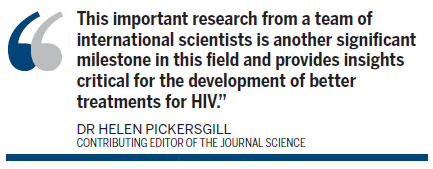Chinese scientists lead breakthrough in HIV research
Chinese scientists together with US experts have determined the high-resolution structure of one of two gateways HIV uses to get into the human immune system, which could help develop better HIV drugs in the future.
The research was led by scientists from Shanghai Institute of Materia Medica under the Chinese Academy of Sciences, and the study result was published in the peer-reviewed journal, Science.
CCR5, a receptor on the surface of human cells, is one of two main entry points the HIV virus uses to initiate its attack on the human immune system. By binding to the receptor, an HIV protein can fuse to the cell membrane beneath, ultimately digging its way inside the cell.
Both CCR5 and CXCR4 belong to a family of proteins called G-protein-coupled receptors, or GPCRs, which mediate a range of functions in the body and are thus important drug targets.
Only recently, however, have scientists been able to image GPCRs at high resolution, a critical step for drug design.

"Structural studies of GPCRs are enormously challenging," explains Wu Beili, a researcher from the Shanghai Institute of Materia Medica, who participated in the study.
CXCR4's structure has already been solved, but even so, aspects of how this receptor recognizes and binds to HIV viral proteins remain unclear.
In this study, Wu and her colleagues have gotten the first precise look at CCR5, which HIV strains penetrate more often, by using a drug for treatment of HIV-1 called Maraviroc.
This drug is a CCR5 receptor antagonist that works by binding the co-receptor so it's unavailable to circulate the virus.
Wu and her colleagues allowed Maraviroc to bind an engineered CCR5 receptor. Then they purified and crystallized the resulting receptor/drug complex at 2.7 angstroms - a very high resolution.
Based on the study, scientists have received a series of critical insights, which will assist them in improving existing HIV drugs based on CCR5 inhibition, and also in creating new HIV drugs.
"We hope that the structure we determined can be used to understand the molecular details of the current viral strains of HIV entry, to develop new molecules that can inhibit both CXCR4 and CCR5 receptors, and to block future strains that might emerge and be addressed with second-generation HIV-entry inhibitors," Wu says.
"This important research from a team of international scientists is another significant milestone in this field and provides insights critical for the development of better treatments for HIV," says Dr Helen Pickersgill, contributing editor of the journal Science.
Related: Work & Work out


















